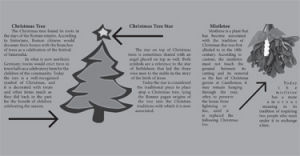Christmas traditions – what are its origins
December 2, 2009
Each year as winter descends upon the community [and lights begin to shine out the season,] people of faith begin the process anew of celebrating Christmas.
However, Christmas has not always been a time of cheer and celebration. Some historians trace the roots of Christmas back to the pre-Christian days of the Persian and Roman empires, in which some of today’s traditions originated, such as the Christmas tree (which descends from a Roman tradition at its roots), and the idea of a large feast on Christmas, which is traced back to pre-Christian Scandinavian roots as well.
The colorful history of Christmas went well into the modern age under the Puritan movement of the Reformation in the 19th century, which actually condemned the celebration of Christmas and banned it in parts of New England at one point, where it wasn’t considered to be acceptable practice even after the ban was lifted up until the mid-to-late 1800s.
Today, however, traditions that have been passed down through the generations and have taken form from sacred ceremonies have become more accessible to the public than ever before.
In the case of First Southern Baptist Church of Topeka, located near 19th and Gage, many of the church’s traditions revolve around the story of the birth of Christ, who is embraced as part of the holy trinity of God the Father, God the Son and God the Holy Spirit. They represent this through a candlelight service.
“We come together as a congregation to raise up the light of our savior on Christmas Eve,” said Clark Johnson, senior pastor at the church
Many other denominations celebrate in similarly traditional ways of worship. For example, the Methodist tradition is the “hanging of the greens,” which dates back as far as the pre-Christian days of the Roman empire. The hanging of the greens has continued through the centuries, eventually turning into what Methodists and most other denominations of Christianity do in hanging branches of trees as well as is more commonly practiced in the decoration of a Christmas tree.
“We enjoy the warmth and the community that hanging the greens brings to our church,” said Loretta Ross, assistant pastor at Crestview United Methodist church.
Catholic traditions, while similar to many of the protestant denominations in some regards, are unique in other ways. This is illustrated in events such as St. Nicholas Day, celebrated on Dec. 6 every year. It is a highlight of the Advent season. Each child puts out a shoe the night before St. Nicholas Day in the hope that the kind bishop — with his miter, staff and bag of gifts — will pay a visit. The current “Santa Claus” is modeled after St. Nicholas, but commercialism has tarnished the true story. Many families give gifts on both Dec. 6 as well as Christmas.
While no one from the local Catholic community could be reached for interview prior to this article going to deadline, this writer felt it appropriate to let one of the more notable pontiff’s of the Catholic church speak in this article in reference to another of the traditions of the Catholic faith:
“The Christmas tree is an ancient custom that exalts the value of life, because the evergreen tree remains unchanged through the harshness of winter. When gifts are arranged under the tree, it becomes a symbol of the tree of life, a figure of Christ, God’s greatest gift to all men,” said Pope John Paul II during his angelus audience Dec. 19, 2004.
Regardless of which denomination one belongs to, or where one goes for spiritual celebration this holiday, the season is just another historical touchstone in the time of year that marks the celebration of something like the birth of Christ for those that believe and embrace the message.



